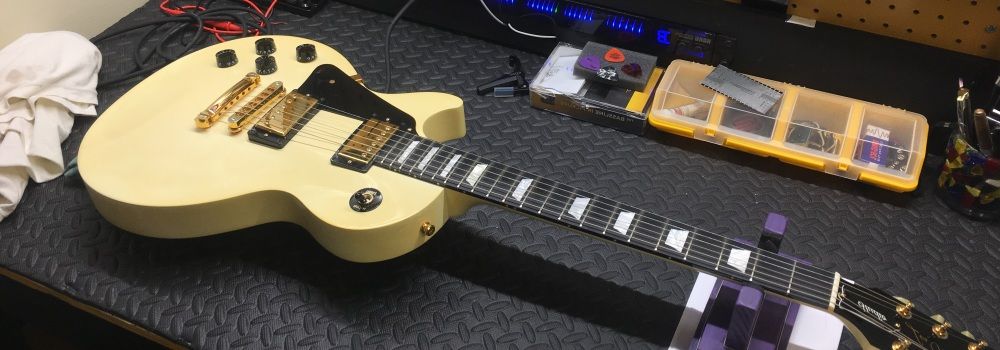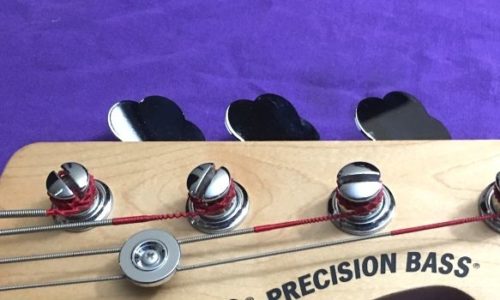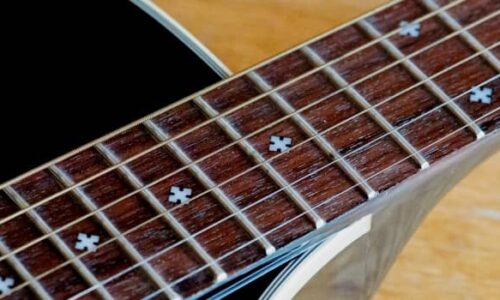10 Easy DIY Guitar Maintenance Tips

Pro Tips for DIY Guitar Work
Learn some simple tricks to improve your DIY guitar maintenance and repair work. Learn how to do better work and minimize the chance of common preventable problems.
Learn How to Take Care of Your Gear
If you have anything of value you need to understand how to take care of it. This is certainly true when it comes to your acoustic or electric guitar or bass. Even if you rely on a luthier or guitar tech to do service work, you can still help with the care of your gear.
1. Handle Your Guitar With Care
Almost every dent, scratch and abrasion could have been prevented. Most of this damage occurs from a momentary lapse of judgment. From banging your guitar into something, placing it where it was able to fall, or failing to use a protective case most damage is avoidable.
Don’t eat or drink near around your guitar. One spilled drink can cause electrical problems, cause screws or hardware to rust, and sometimes damage wood finishes.
Protect it other people. Some roommates, kids, and guests can’t keep their hands off of your guitar. If you’re working on it and need to stop, either put it away or ask them to not handle it. Personally, we advise you to never trust cats. They’ll jump on your guitar and just look at you.
2. Protect Surfaces While Doing Work
When it comes to working on your guitar, always place it on a padded, soft surface. Minimize reaching over the guitar for tools and other items you could drop on it.
Tape is cheap and t-shirts are super handy. In many situations, you should take a few minutes to tape-off or otherwise cover non-work areas. This is especially true if you are soldering over or near your guitar. Taping off your fretboard to polish frets is a non-brainer.
3. Love Your Screws
When you’re replacing screws, keep in mind that they’re not holding down the main guns on a battleship. Tighten them enough to be snug but do not crank them down as tight as you can.
Before you install a screw, swipe the threads through a little candle wax. It lubricates the threads and gives it a tiny bit of corrosion protection. You’ll find it’s then much easier to remove them later. You may be interested in a forum discussion on what kind of lubrication to use on guitar screws, where wax is the top suggestion among guitar players.1.
And note this, always use the appropriately sized screwdriver. Using the wrong size screwdriver is a quick way to strip out the head.
4. Periodically Check Fitness
From screws holding strap buttons, hardware and knobs to pickguards you should periodically make certain things are not coming loose. If not, you’ll almost certainly discover one day that a screw has gone missing.
5. Keep Cover Plates Installed
Believe it or not, the top guitar manufacturers actually know what they are doing – including putting cover plates on cavities. If it made a guitar sound better (and would lower manufacturing costs) they would leave them off. Forget what your friends say about “it looks cool” or “you can change strings faster” or “your tone will be awesome”. Cover plates are protective, Use them.
6. Clean Your Guitar
It’s easy enough to play your guitar, then just set it aside. Investing a little time to care for your guitar’s appearance will keep it looking great and also preserve its playability. In fact, the experts at Premier Guitar published an article with a lot of information on cleaning a guitar, including compelling reasons to do so. Author John LeVan stated, “Over time, sweat, dirt, and oils build up on the guitar’s finish and slowly break it down. This causes the finish to develop a hazy film and become discolored. In addition, if your sweat has a high acid content (low PH balance), it can actually cause the finish to deteriorate, especially where you rest your arm. Sweat contains water, acids, salt, and several minerals that are corrosive to finishes and hardware. When you add in environmental issues, such as dust and pollen, it’s no wonder our guitars get so filthy.”2
7. Use Hangers Instead of Racks
Using wall-mounted hangers is vastly superior to storing your guitars in racks. Over time, an instrument hanging vertically will not develop neck issues like one stored in a rack. Gravity, the distribution of weight, and effects of pressure are undeniable factors in shaping wood (good or bad).
More reasons for using wall-mounted hangers? The folks at Guitar Grip recently wrote an article that gave 5 reasons to mount your guitar with a guitar hanger. Specifically, they cited spatial design, motivation, convenience, out of reach, and safely preserved.3
When upgrading to wall-mounted hangers, we highly recommend the style of guitar hangers with locking tabs. This is your best assurance of preventing a catastrophic fall. It’s worth mentioning that you need to be careful when using these from Thinline necks that may fall through the hanger. When you install the hanger it’s a good idea to make certain at least one of the screws goes through the drywall and into a wall stud.
8. Keep An Eye on Humidity
Wood is highly responsive to the amount of moisture dissolved in the air. This is especially true with acoustic guitars. Ideally, you can keep your guitar in a climate-controlled environment where relative humidity stays around 45-55%. To keep an eye on this you can go to Amazon or eBay and pick up a Hygrometer for around $15. The pros at Gearank.com wrote an article that says, “Humidifying your guitar is an important part of maintaining your instrument. So to protect your precious instrument from damage, you’re going to want to find the best guitar humidifier for your situation.”4
If you keep your guitar in a reasonable level of humidity and stable temperatures you’ll find playability (tuning, etc.) is easier to manage. Extreme dryness or humidity levels can actually ruin an acoustic guitar. See our article on How to Prevent Guitar Humidity Problems.
9. Keep an Eye on Temperature
Temperature is another out-of-mind factor in guitar maintenance. In addition to humidity, wood is also very sensitive to temperature changes. If you ever heard an old house creak or pop at night its because the wood is adjusting to the temperature dropping. Although on a smaller scale, your guitar will do the same. Too much expansion and contraction can crack finishes and cause laminated joints to break. At the very least, the expansion and contraction will play havoc on your neck (meaning tuning and intonation). Try to keep your guitar in a relatively stable temperature range.
10. Change those strings!
Yeah, guitar strings cost money (especially if you’re a bass player!) and are not a glorious purchase. It’s easy to slowly get used to those old, corroded, dirty strings and not notice what it does to your playability. Dropping a few bucks on a good set of strings will make your guitar tone better and they will feel much better. If you don’t know how to change your guitar strings simply catch a few YouTube videos. You can learn how to change guitar strings in under 10 minutes.
If you really like your guitar, learn to take good care of it. Read available info but beware of advice from idiots on forums. Always get information from reliable sources, and put your knowledge to work.
FOOTNOTES
- 1 Various, “What kind of lubrication to use on guitar screws?”, September 27, 2011, Available from Unofficial Warmoth Blog
- 2 John LeVan, “Guitar Shop 101: Safe Ways to Clean Your Guitar’s Finish”, November 29, 2013, Available from Premier Guitar
- 3 Michael Pierce, “The Top 5 Guitar Wall Hangers”, October 22, 2018, Available from EquipBoard
- 4 Mason Hoberg, “The Best Guitar Humidifiers & Case Hygrometers”, November 8, 2017, Available from Gearank.com




Putting a little effort into general maintenance can save you the heartache of having a guitar that feels awful to play as well as time and money in the long run.
I think most people get lazy and overlook the importance of maintaining things they own. It takes only a couple of minutes after playing your guitar to keep it looking good and become aware of issues that need attention.
This article is very good and is helping me to take better care of my guitar. I have a guitar recently and I never thought it was to be especially careful with the humidity. Congratulations and thank you very much.
Never saw the number one way to keep your instrument in good shape…lol wash your hands before playing it.
I have read all these maintenance tips and these are effective for guitar maintenance. For maintenance purposes, it is also good to know about the guitar parts such as the tailpiece unit, fretboard, neck, strings, and bridge. I have recently repaired the Les Paul bridge part of my Gibson guitar and I have brought this from the Faber USA online store for guitar parts.
I have a Gibson guitar and I want to do all repairs for my guitar by myself. Your article is one of many that helps people like me. Thanks!
The bottom line is to take good care of your guitar. You’ll have very few problems and a reliable, quality instrument.
I’m really pleased to say your post is easy to read and understand. I learned stuff from your article that I can actually put to work.
Nice article. It’s good to know how to keep my guitar looking good!
I’m a new player and was looking for solid info on how to take care of my guitar. Your article gave me a lot of useful information, Thanks guys!
Excellent tips for taking care of a guitar. Well written and easy to follow.
Un videogame de consolas como cualquiera otro. si bien muy excelentes graficas
So, a buddy of mine bought an old guitar from a pawn shop. Now he’s looking for somewhere that can repair the old instrument. I’ll be sure to let him know how you mentioned that wall-mounted hangers are superior to racks.
Really good stuff. Could you write an article on the best products for cleaning and taking care of gear?
Great ideas for taking care of your guitar. I make it a point to take one day a month to go over all of my guitars. By doing regular inspections and maintenance I’ve never had an unexpected problem, and my guitars are always in great playing condition.
I used your info when I was rewiring my Epiphone and got really good results. Your information gave me the confidence to tackle the job. Thanks!
Nice article! I scored 7 out of ten but I’ll now be doing all of these tips. Thanks for writing a useful article!
I was excited to discover your website and find great articles on guitar maintenance. I want to thank you for your time to create easy to read articles.
I bookmarked this article and referred my friends to a couple more. Rock on!